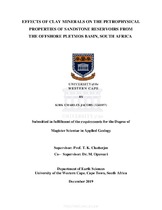| dc.description.abstract | With the latest advancements in the Pletmos Basin it is imperative to understand and study how sandstone reservoirs are affected by clay minerals. Clay minerals are an influential component in sandstone reservoirs worldwide and thus have an impact on the reservoir quality and petrophysical properties. The present research was aimed at assessing the effects of clay minerals on the petrophysical properties of sandstone reservoirs from the Offshore Pletmos Basin. This was done by integrating geological (wireline logs and core analysis), geochemical (XRD and pore water chemistry) and petrographical (QEMSCAN and thin section petrography) analysis to highlight the effects of clay minerals on the intrinsic properties (porosity, permeability and fluid saturation) on reservoirs encountered within the two wells (Ga- Q1 and Ga – S1).
The results highlight pervasive quartz cementation as well as the presence of clay minerals: Glauconite (Illite group), Kaolinite (Kaolinite group), Clinochlore (Chlorite group) as the dominant clay minerals and Calcite as the dominant cement in both well Ga – Q1 and well Ga – S1. The most abundant clay mineral in both wells is Glauconite. This clay mineral had a more profound effect on the petrophysical parameters compared to the other clay minerals. The clay minerals occur as pore–filling Kaolinite and pore–bridging Glauconite and pore–lining Clinochlore. As a result, the clay minerals affected the pore connectivity (permeability) more than the pore spaces (porosity). This is confirmed by the petrophysical analysis where both wells have extremely low permeability and good porosity values. The study concludes that the presence of Glauconite, Kaolinite, Clinochlore and Calcite in both wells (Ga-Q1 and Ga-S1) had an adverse effect on the permeability more compared to the porosity in sandstone reservoirs. Due to the high volume of clay and high clay mineral content in well Ga-Q1, the petrophysical parameters were more adversely affected compared to well Ga-S1. As a result, we see better petrophysical properties (porosity and permeability) in the sandstone reservoir from well Ga-S1 due to intense bioturbation. The reservoir quality of well Ga-S1 is much better compared to well Ga – Q1 because water saturation averages at 42% and gas saturation averages at 58%, has decent porosity averages at 12% but low permeability ranges of 0, 1 – 4mD. | en_US |

